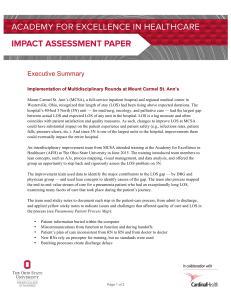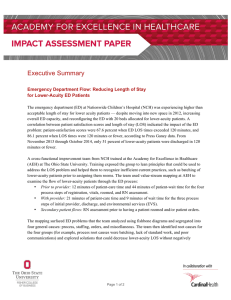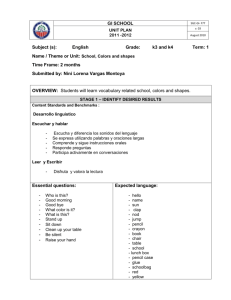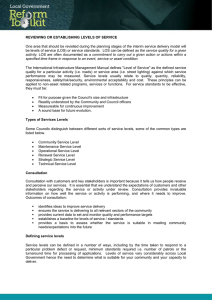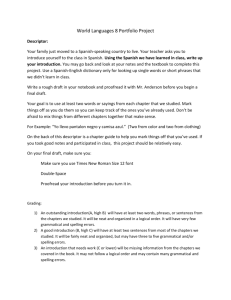Document 10947632
advertisement
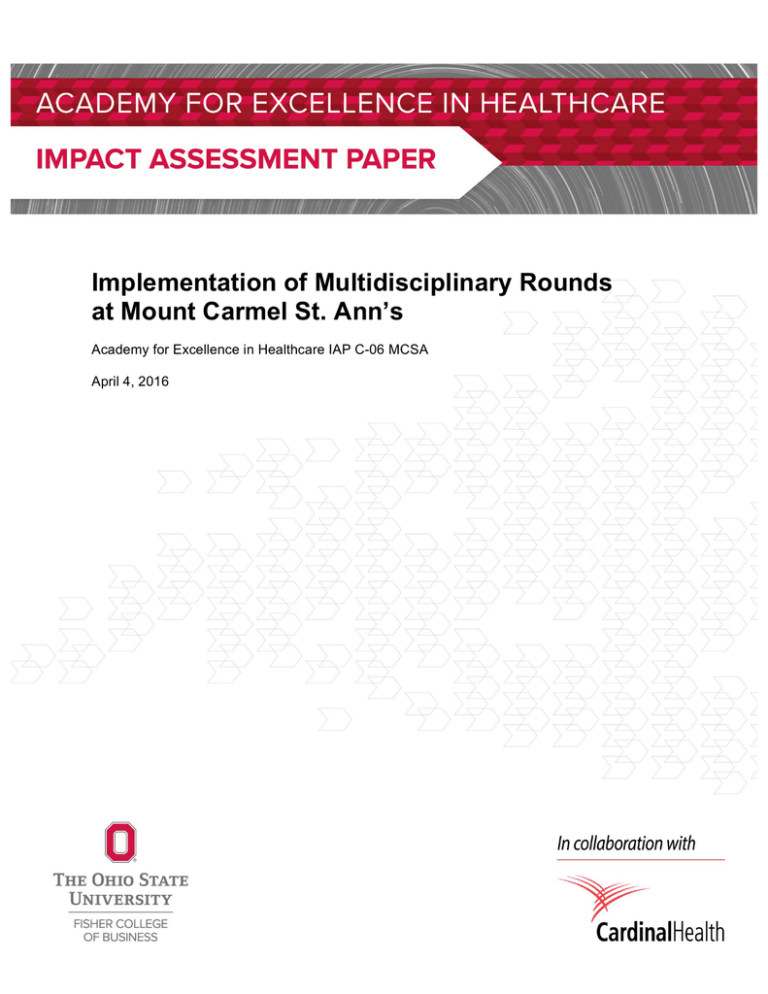
The Academy for Excellence in Healthcare The Ohio State University Implementation of Multidisciplinary Rounds at Mount Carmel St. Ann’s Academy for Excellence in Healthcare IAP C-06 MCSA April 4, 2016 fisher.osu.edu 1 The Academy for Excellence in Healthcare The Ohio State University Implementation of Multidisciplinary Rounds Collaborative improvements reduce length of stay and improve patient care Longer than expected length of stay (LOS) at hospitals can quickly roll into problems for patient safety and financial losses for providers. Medicare pays hospitals based on the diagnosis-related group (DRG) classification for a hospital case, not on the LOS of the patient. A single additional day of patient care can cost providers hundreds of dollars. With private insurers likely to follow the Medicare payment model, hospitals have little alternative but to more effectively and efficiently treat and discharge patients. Mount Carmel St. Ann’s (MCSA) in Westerville, Ohio, recognized that LOS had been rising above expected durations. The hospital’s 40-bed 3 North (3N) unit — for med/surg, oncology, and palliative care — had the largest gap between actual LOS and expected LOS of any unit in the hospital. LOS is a lag measure and often coincides with patient satisfaction and quality measures. As such, changes to improve LOS at MCSA could have substantial impact on the patient experience and patient safety (e.g., infections rates, patient falls, pressure ulcers, etc.). And since 3N is one of the largest units in the hospital, improvements there could eventually impact the entire organization, says Amber Bidwell, Clinical Manager and a member of an MCSA improvement team to lower the LOS gap. Cintia Ulloa-Hays, Performance Excellence Manager, was examining fiscal year 2016 LOS goals for the entire hospital, and Liza Paul, Case Manager and Social Work Manager, was reviewing LOS for the 3N discharge process when a team was assembled to address the problem. “We knew we wanted to work with the 3 North team because we had been through multiple lean training [5S workplace organization, visual management, leader standard work], and we felt like the unit was culturally ready for the change and had a lean foundation in place,” says UlloaMount Carmel St. Ann’s (MCSA) Hays. Improvements to the patient experience and discharge process would be piloted and validated Mount Carmel St. Ann’s is a full-service on 3N, and if successful implemented inpatient hospital and regional medical center hospitalwide. An interdisciplinary improvement team from MCSA attended training at the Academy for Excellence Healthcare (AEH) at The Ohio State University in June 2015. A team from a sister Mount Carmel hospital had attended AEH training, and their report-outs convinced the MCSA team that such an experience would help to focus their attention on the LOS initiative — the initial phase of the AEH training consists of five consecutive days in Columbus. The MCSA team submitted their project to AEH, and the team was accepted into the program. fisher.osu.edu in Westerville, Ohio, and a member of the Mount Carmel Health System. MCSA includes: • Fully integrated cardiovascular center of excellence with open-heart capabilities • Primary Stroke Center • Dedicated Women’s Health Center • Maternity Pavilion (more than 4,500 babies annually) • Network Cancer Program • The first Cyberknife® robotic radiosurgery center in central Ohio • Dedicated orthopedics and spine unit 2 The Academy for Excellence in Healthcare The Ohio State University The AEH training introduced MCSA attendees to lean concepts, such as A3s, process mapping, visual management, and data analysis. Bidwell says AEH training helped to give the group an opportunity to step back and really assess the problem, rather than trying to quickly force solutions. The team also went to AEH with preconceived perspectives of the problem, which were not entirely accurate: “So to step back, break things down, and take our time looking at it really was a learning experience for all of us.” Understanding the LOS Problem The MCSA improvement team looked to data to get them started on decreasing LOS on 3N. “We had an idea as to what we thought our main challenges were, as far as which physician group might have the longest lengths of stay, from what we see day to day on the floor,” says Bidwell. “But we really didn’t have any idea as far as the DRGs or diagnosis which patients we would be Mount Carmel St. Ann’s Improvement Team focusing on, so we really had to dive down into the data.” • Nicole Wolf, Nurse Manager • Amber Bidwell, Clinical Manager The team identified sepsis as the DRG • Liza Paul, Case Manager and Social Work Manager with the longest LOS, but that would be • Cintia Ulloa-Hays, Performance Excellence Manager difficult for the team to impact because • Dr. Martha Reigel, VPMA and Executive Sponsor many factors were beyond 3N control: • Don LaFollette, CNO and Executive Sponsor patients with sepsis typically come from ICU or other immediate care unit. The DRG with the largest LOS gap (actual vs. expected) was pneumonia (a group consisting of both simple pneumonia and COPD chronic pneumonia), and those patients usually start and finish their MCSA stay in 3N (see 3N LOS Gap). The pneumonia patients’ actual LOS vs. expected LOS gap was 4.05 days (simple pneumonia) and 7.0 days (pneumonia). 3N LOS Gap Source: Mount Carmel St. Ann’s fisher.osu.edu The MCSA improvement team similarly examined physician groups with the largest LOS gaps; the physician group with the largest gap had a low percentage of patients, and the team recognized that focusing on that group would have little impact on overall 3N LOS performance and patient satisfaction. The physician group with the second largest LOS 3 The Academy for Excellence in Healthcare The Ohio State University Pneumonia Patient Process Map Source: Mount Carmel St. Ann’s gap accounted for 59 percent of 3N patients and cared for a high percentage of pneumonia patients. With an understanding of the major contributors to the LOS gap — by DRG and physician group — the team set out to identify causes. They process mapped the end-to-end value stream of care for a pneumonia patient who had an exceptionally long LOS, examining many facets of care that took place during the patient’s journey. The team used sticky notes to document each step in the care process, from admit to discharge. “We pulled data from the patient chart and went through it, using the physician and nursing notes, to determine what happened with that patient during their stay, step by step, day to day,” describes Bidwell. “We pulled in an interdisciplinary team. We had a case manager, a staff nurse, a physical therapist, and a respiratory therapist. We pulled together all the different disciplines who would work with those patients, and then we pulled the actual chart data and went through the process map.” The map was extensive and stretched across a room (see Pneumonia Patient Process Map). Team members applied yellow notes to indicate where issues and challenges that affected quality of care and LOS existed in the process. Twenty-one yellow notes were placed on the map, which included: • • • • • Patient information buried within the computer Miscommunications from function to function and during handoffs Patient’s plan of care inconsistent from RN to RN and from doctor to doctor New RNs rely on preceptor for training, but no standards were used Batching processes create discharge delays The process-mapping exercise, which was new to many of those involved, eventually got all the steps aligned and occasionally became “animated,” says Paul. Gradually the interdisciplinary team was comfortable with their collective observations and the issues they had highlighted. Physicians joined the session and became aware of barriers they did not know existed, and they became aware of problems to which they contributed. For example, pneumonia patient-care teams often did not know the target date for discharge: “Everybody has a role in the patient discharge process,” says Ulloa-Hays. “If we can identify fisher.osu.edu 4 The Academy for Excellence in Healthcare The Ohio State University that discharge date, then everybody can get their actions done on time, without creating a delay for the patient.” From the team’s list of 21 issues, communication was the most prevalent theme, such as lack of communication between disciplines and lack of communication with patients and families. The MCSA team also recognized that better discharge planning was needed to align all internal resources. The team focused their development and implementation of countermeasures on the following: • Multidisciplinary rounds (MDRs): With all disciplines, including physicians, involved in a patient’s care in attendance, the multidisciplinary group discusses the patient’s plan of care for the next 24 hours, the discharge date, and unmet requirements that could delay discharge. Ulloa-Hays says process mapping helped to build the necessary buy-in to implement multidisciplinary rounds (MDRs): “Instead of dictating MDR implementation, the team realized the 21 issues identified in the process-mapping session would be resolved by holding daily MDRs. We had immediate buy-in.” • MDR visual board: The MDRs take place in front of an MDR visual board, where key quality and safety information for each patient, such as expected LOS and the patient’s care plan for the next 24 hours, is updated regularly and displayed on the board. Patient safety is also discussed daily and recorded on the board (e.g., days with a Foley catheter, central lines, skin-integrity issues, readmission patient) for visibility. • Discharge checklists: Standard work and tasks are identified for various roles to ensure that patient activities stay on track for their discharge date. The detailed checklist contains tasks, including follow-up on discharge needs (home care referral); follow-up on discharge needs (infusion services); check readmission assessment; medication reconciliation; and check on patient education, scheduling, and transport. • Elimination of batching: Greater awareness of the negative impact of extended LOS will help to focus staff on an individual patient’s discharge and other care requirements, rather than batching activities for a group of patients. This work occurred soon after returning from OSU. During one staff meeting, Ulloa-Hays introduced everyone to basic lean concepts and conducted an exercise on batching that revealed how it leads to delays in all manner of activities, especially discharge delays. “Case managers and the social workers walked out of that meeting feeling empowered that they could speak up, that they could move the process along if they change their daily work routine,” says Paul. “We had a physician attend the training with us. His greatest takeaway from the one-piece flow exercise was understanding the impact that batching had on the rest of the hospital,” says UlloaHays. “He realized that by batching orders, he was creating a four-hour delay for the nursing staff, and ultimately delaying the patient’s discharge.” The physician would see the first patient fisher.osu.edu 5 The Academy for Excellence in Healthcare The Ohio State University during the 7 am rounds, but would not put in their orders until noon, after they had rounded on all of their patients. This created a spike in activities hospitalwide, from diagnostic testing to RN activities to patient discharges. Lowering the LOS Gap and Improving Quality of Care The team had established a goal for their project to reduce LOS for pneumonia patients by 20 percent, and shorten the LOS gap to 0.5 days by December 2015. The goal was developed when the team worked on their initial A3 for the project at AEH. The team believed it was an attainable goal, but in hindsight admits they were unsure of the impact their work would have across the unit. By September 2015, the 3N project had reduced LOS by 28 percent, and the gap between expected and actual LOS was only 0.1 days. The team was surprised that they had achieved these goals, especially since MDRs did not begin until September. In December the 3N LOS gap was still 0.1, and in October and November the actual LOS was lower than the expected LOS, which had not occurred in 16 months (see LOS Initial Results). “The people impacting length of stay are the front-line staff and the physicians,” says Ulloa-Hays. “MDRs made the staff aware of where we have gaps in our processes, and they are able to directly impact those gaps. Paul adds, “Case managers have a sense of ownership for the patient’s stay and care. They are speaking up and advocating for the patients: Are we doing the interventions that are needed to move the patient to the next level?” The cross-functional 3N team achieved its initial goals, and if this level of performance is sustained it will result in annual savings of more LOS Initial Results than $660,000 for the hospital. Even as the case mix of 3N patients increased (higher acuity patients), the LOS for the unit decreased. Source: Mount Carmel St. Ann’s fisher.osu.edu Although the project was piloted on pneumonia patients and measured by LOS, the cultural and organizational effect from the improvement effort positively impacted all 3N patient groups and plan-ofcare processes, notes UlloaHays. Improved quality of care 6 The Academy for Excellence in Healthcare The Ohio State University and patient safety and satisfaction were reflected in Press Ganey scores for MCSA 3N, which rose dramatically from June 2015 to October 2015: • Rate hospital: 50.0 to 89.7 • Communication with nurses: 69.2 to 96.6 • Communication with doctors: 67.5 to 82.1 The team expects the continuing use of MDRs will enable them to sustain and build upon improvements and provide collateral benefits for patients. The team was also successful because of the support of Mount Carmel’s VPMA Dr. Martha Reigel and CNO Don LaFollette, the team’s executive sponsors. They were able to remove barriers to MDR implementation and set the expectations. For example, geographic rounding had to be established by the hospitalist physicians to ensure they were part of the daily MDR discussions on the units. Eventually, two physicians were assigned to all 3N patients and “now they’re in there talking about every single one of their patients, every single day,” says Ulloa-Hays. Other physician groups and physicians have also been added to MDRs, which occur at 2 pm every day. Expanding the Model and Lessons Learned “There’s a lot of momentum to continue to roll this out across the hospital because the results have been so consistent and positive,” says Bidwell. The success has led other hospital units, such as 2 North (2N), to begin implementation of the discharge-process model (see MDR and MDR Visual Board at 2N), and other Mount Carmel system hospitals are MDR and MDR Visual Board at 2N beginning to follow suit. For example, team member Paul has transferred to Mount Carmel East, where MDRs are now being used. Ulloa-Hays also has begun to work with other St. Ann’s units in deploying the model. She and 3N team members caution others — at Mount Carmel or elsewhere — to be prudent in order to get the results they expect. “Since we’re rolling this out on other units and in other hospitals, I think the most important thing is to involve the people who will be part of the change from the beginning. Go slow to go fast. Process map a patient Source: Mount Carmel St. Ann’s flowing through the unit so everyone understands the impact of MDRs: where the patient benefits, where the staff benefits, and where the physicians benefit. We found a recipe that works,” says Ulloa-Hays. fisher.osu.edu 7 The Academy for Excellence in Healthcare The Ohio State University “You need support from the top of the organization,” adds Ulloa-Hays. “When you run into a barrier, the executive sponsors are there to help.” Without VPMA and CNO buy-in, physician involvement or ancillary staff involvement is unlikely to occur and that will negatively impact outcomes. It was enlightening to step back and trust the process, says Paul. “There’s a reason behind it, and to me, trusting the process means going to the gemba to see what the staff is doing, and finding out exactly what is happening. We get caught up in meetings, but for me to be able to [meet with my team] and say, ‘Let’s talk about your day and let’s find out what the challenges are,’ was truly eye-opening. And it was empowering for them to be able to do that for themselves.” Ulloa-Hays adds that a big part of the success with MDRs and the overall project is that they tried and recognized that changes will be necessary along the way: “We knew it wasn’t going to be perfect, and we tried it. We explained to everybody that we were going to have to tweak. In fact, we met a month after we kicked off MDRs on the unit to touch base with everybody again and see what they were liking about MDRs and what they weren’t liking about MDRs. We made some good changes after that one month follow-up that made us even more effective and more patient-focused.” AEH Commentary The project at Mount Carmel St. Ann’s (MCSA) focused on shortening the gap between actual LOS and expected LOS, and involved every discipline that touches a patient in the hospital 3N unit. It illustrates that all disciplines involved in a problem must be aware of the issues involved, underlying causes, and how their role contributed to outcomes. Multidisciplinary understanding of a problem helps to collaboratively develop solutions and builds the buy-in necessary for those solutions to succeed. And when everyone discusses patients in a standard manner every day, a consistent message is communicated to patients and their families, building trust and confidence. In their effort to lower LOS and improve patient safety and quality, the MCSA team relied on data in many ways: to identify where best to focus their project and pilot countermeasures, to track the effectiveness of their changes, and to communicate and promote the efficacy of their work in order to engage other Mount Carmel units and hospitals. Lastly, the MCSA team ran into and addressed a problem that affects virtually every kind of healthcare process in every type of facility — batching. Many care providers believe they are being efficient by holding on to like tasks until they can be processed as a group, such as writing and executing discharge orders. It takes training to break this mindset: to healthcare professionals and those throughout industries, many lean concepts, such as one-piece flow, on the surface seem counterintuitive. But when these principles are understood, trialed, and implemented, they are almost always eye-opening and effective. fisher.osu.edu 8 The Academy for Excellence in Healthcare The Ohio State University About AEH The Academy for Excellence in Healthcare blends in-person class time with hands-on project work, interactive simulations, and recurrent coaching, all aimed at helping healthcare teams spark actionable change at their organization. At the heart of this program is a real-world workplace problem each participant team selects and commits to solving through five intensive days on campus, followed several weeks later by two days of project report-outs and lean leadership training. This project-based approach pays immediate dividends and lays the groundwork for transformational change. MDR Project • Cintia Ulloa-Hays Performance Excellence Manager Mount Carmel St. Ann’s 614-865-8063 cintia.ulloa-hays@mchs.com • Margaret Pennington Faculty Director The Academy for Excellence in Healthcare The Ohio State University 614-292-3081 pennington.84@osu.edu For Program Information • fisher.osu.edu Beth Miller Program Director The Academy for Excellence in Healthcare The Ohio State University 614-292-8575 miller.6148@osu.edu 9
